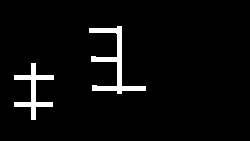Stýrivolt
The first version of this page was based on the article Stýrivoltur, by Jógvan Bærentsen, in Varðin, vol. (bind) 43, part (hefti) 3/4, (1975) pages 162-168, translated into English by Anthony Smith, who also had the opportunity to join in a game in Tórshavn on Wednesday 23 October 1996. In April 1998 the page was revised and expanded John McLeod, with the benefit of comments, corrections and further details supplied by Jógvan Bærentsen.
- Introduction
- Players and Objective
- The Cards and their Ranking
- The Deal and Choosing Suits
- The Play
- Taking the Stock
- The Scoring
- Tactics and Customs
- Variations
Introduction
Stýrivolt is a card game which is more than 300 years old and was probably invented in Denmark. It has been played in the Faroe Islands for over 200 years and is, for example, mentioned by J. C. Svabo in his "Indberetninger fra en Reise i Færöe, 1781 - 1782". A comparison of Faroese stýrivolt with the Danish version which was played around 1800 (and described in, for example, "Politiske Spille Regler for de tilladelige og meest brugelige Spil i Vertshusene", Kebslein, 1774, Copenhagen, of which there is a copy in the Royal Library at Copenhagen) shows that the game has altered only slightly in all these years, only the terminology having changed. It seems that the game was known as early as 1648 in Sweden. According to the catalogue "Trumpf på hand: en historia om svenska spelkort", Uddevalla, 1993, on page 8, the poem "Herkules", published in 1648 by the Swedish poet, Georg Stiernhielm, mentions some 15 different card games including one called "stýr-wålt".
Stýrivolt belongs to the Karnöffel group of card games, whose documented history reaches back to the early 15th century. These were the earliest games in which special cards, belonging to a chosen suit, had the power to beat cards of other suits. In Stýrivolt there are in fact two chosen suits. They operate rather like trumps in modern trick-taking games, but with important differences: some of the cards of the chosen suits have no special power, some can only beat certain unchosen cards, and some are powerful only if led to a trick. A few of the terms in the Faroese game are directly derived from the medieval German words for the same cards: karnifl from Karnöffel for the jack of a chosen suit; pavstar (now postman) from Pabst (pope) for the six.
As Stýrivolt is not played in many places in the Faroes nowadays and scarcely at all in Denmark, there is a danger that the game will soon die out. Even though it has not yet reached its end, it is certainly only just alive. The game is perhaps a bit complicated to grasp at first and a lot of terminology has to be learnt. But once the basics have been mastered the game is extremely entertaining and makes no greater demand on its players than the rapidity of the talk while it is played. The many characteristic expressions used add a special colour to the game.
Stýrivolt is played in a variety of ways in the various villages in the Faroes, and the names of the cards also vary. The description given here is of the version usually played in Kvívík, which is 26km by road from Tórshavn.
Players and Objective
Four people play, two against two in partnerships. Partners sit opposite one another. Each player has a hand of nine cards which are played out in tricks. The team which takes the majority - at least five tricks - wins the hand. Won hands are scored on a chalk-up by erasing strokes and marking crosses (see below). A team's objective is to collect as many crosses as they can.
The Cards and their Ranking
The tens are taken out of a normal 52 card pack, leaving 48 cards. The ranking of these cards for trick taking purposes is rather elaborate.
In each deal there are two chosen suits. The ranking of the cards in the suits that are not chosen, from high to low, is A K Q J 9 8 7 6 5 4 3 2, with the exception of certain cards, called permanent stikkar, which are depicted below.
The most powerful cards in the pack are the nine stikkar. They beat all the other cards, with the exception of a lamb (chosen seven) that has been led.
The top five stikkar are permanent - they do not depend on what suits are chosen. From high to low they are:
 |  |  |  |  |
|---|---|---|---|---|
| bird | fyrik | eight | hay-yard mare | mare of diamonds |
| Fuglurin | Fýrikurin | Áttuni | Hoygarðsryssa | Rútar-ryssa |
The remaining four stikkar are the aces of the chosen suits (stýrivoltar) followed by the jacks of the chosen suits (karniflar). These are followed in rank by the tøkukortini (taking cards), in the chosen suits, the sixes, twos, threes and fours, which can beat some but not necessarily all cards in the unchosen suits. Here is the full list of stikkar and tøkukortini, from high to low:
| Permanent stikkar | bird | Fuglurin | Beat all other cards except lambs | |
|---|---|---|---|---|
| fyrik | Fýrikurin | |||
| eight | Áttuni | |||
| hay-yard mare or mare of hearts | Hoygarðsryssa or Hjartaryssa | |||
| mare of diamonds | Rútar-ryssa | |||
| Stikkar | Chosen aces | stýrivolts | stýrivoltar | |
| Chosen jacks | karnifls | karniflar | ||
| Tøkukortini (taking cards) | Chosen sixes | postmen | postar or pavstar | beat aces (except stýrivolts) and below |
| Chosen twos | tvists | tvistar | beat kings and below | |
| Chosen threes | trists | tristar | beat queens and below | |
| Chosen fours | unfortunates | ólukkur (In Bøur, on Vágar island, called pollar) | beat jacks (except karnifls) and below |
The stikkar and the tøkukortini in the two chosen suits beat one another according to the above ranking order. Cards of the two chosen suits are interchangeable, in that a stikkar or taking card of one chosen suit can be beaten by a better card of the same suit or of the other chosen suit. However, there is an old Danish saying "Den ene straffer ikke den anden" ("The one does not beat the other"), meaning that the first played of equal cards in the chosen suits is better - for example if the stýrivolts of the two chosen suits are played to the same trick then the second cannot beat the first one played.
The other cards of the chosen suits have no power unless they are led to a trick. The operate as shown in the following table:
| Chosen sevens | lambs | lomb, but in Kunoy they are called høsn (hens) | Lambs cannot beat anything but also cannot be beaten. If a lamb is led it always wins the trick. However, a lamb cannot be led to the first trick; a lamb may only be led by a player who has already won a trick. |
|---|---|---|---|
| Chosen eights and nines | free cards | fríkort | Free cards do not beat anything. If a free card is led, it can only be beaten by a stikkar. |
| Chosen kings and queens | kings, queens | kongar, frýr | They do not beat anything; the king does not even beat the queen of the same suit, if she is led. Nevertheless they are good leads, for when led a king can only be beaten by a "tvist" or better, and a queen only by a "trist" or better. |
| Chosen fives | traders | keypmenn, but in Gjógv, on Eysturoy island, they are called fimmikar | The holder of a trader exchanges it for the exposed chosen card in the same suit. Traders have no value in themselves in the play. If you attempt to lead a trader to a trick, it behaves as though you exchanged it for the exposed card of that suit, and then led the card you had obtained. |
As already mentioned, the cards in each "unchosen" suit rank in the usual sequence A, K, Q, J, 9, 8, 7, 6, 5, 4, 3, 2. An unchosen card can only beat a lower unchosen card of the same suit. An unchosen card cannot beat a card of a chosen suit in any circumstances. For example, if an unchosen queen has been led and been beaten by a trist, the king of the led suit cannot be used to beat the trist.
If four cards of the same rank are in the same hand they all take on the value of the best of them. For example if you are lucky enough to have four deuces in your hand they become four birds and all rank as highest stikkar, like the ![]() 2. In the same way four nines become four mares and four jacks become four karniflar. If you have four cards of the same rank you do not need to announce this until you play the first card whose rank is altered. At that point you say "Hesin er góður" ("This one is good") to indicate that you have four of a kind.
2. In the same way four nines become four mares and four jacks become four karniflar. If you have four cards of the same rank you do not need to announce this until you play the first card whose rank is altered. At that point you say "Hesin er góður" ("This one is good") to indicate that you have four of a kind.
The Deal and Choosing Suits
The cards are shuffled, but not usually cut. The deal is clockwise, 9 cards to each player, 3 at a time. The turn to deal passes to the left after each hand.
The dealer then uses the remaining 12 card stock to determine the two chosen suits. The dealer takes cards one by one from the top of the stock, holding them so that he alone sees them, and continuing until he has found cards of three different suits (or to the end of the stock in the very unlikely case that it contains only cards of two suits). As soon as a card of a third suit appears the dealer stops taking cards. The first two suits found will be the chosen suits, and the dealer indicates these by putting the "best" card of each of these suits face up on the table. The remaining cards which the dealer looked at are put back in the stock, which now contains ten cards and is placed face down across one end of the chosen cards, leaving the other end sticking out so that the chosen cards' values can be seen.
When selecting which card of the chosen suit to expose, the following rules are followed:
- If a trader of a suit was taken it is exposed.
- If there was no trader in the suit, the highest stikkar in the suit is exposed.
- If there was no trader in the suit, but the lamb was taken, the lamb is exposed, and if there were any stikkar in the suit, the highest stikkar is exposed as well.
- If there was no trader, stikkar or lamb, the highest card is exposed in the following order of priority: six, eight or nine, two, three, king or four, queen (lowest).
For this purpose, the king and the four are considered equal, and the dealer is free to choose which of these cards to expose - see the variations for further discussion. In the same way, the eight and nine of clubs are equal, both being free cards, and the dealer may expose either of these if there is nothing better.
- Examples of choosing suits:
Cards at the top of the stock Chosen suits Exposed cards  2,
2,  K,
K,  3,
3,  J,
J,  9
9hearts and spades  2,
2,  3
3 6,
6,  4,
4,  A,
A,  A,
A,  7,
7,  5
5clubs and diamonds  4,
4,  7,
7,  A
A 9,
9,  5,
5,  4,
4,  7,
7,  6,
6,  2,
2,  9
9hearts and clubs  5,
5,  7
7
A player who holds the five of either of the chosen suits (called the trader) can at any stage of the game take the exposed card of that suit in exchange for the trader. If two cards of a suit are exposed - a lamb and a stikkar - the holder of the trader can choose to exchange it for either card.
The Play
There are nine tricks. The player to the left of the dealer leads to the first trick, and the others each play a card in turn. Any card may be played to a trick - there is absolutely no requirement to follow suit, nor to beat the cards previously played. It is of course forbidden to take a card back into your hand after playing it - even if you accidentally played a "stikkar" on rubbish, once the card is exposed on the table you have burnt your boat.
If a card of an unchosen suit is led (which is not a permanent stikkar nor declared as part of a four of a kind), and no taking card nor stikkar is played which is of sufficient power to beat the previous plays, the highest card of the suit led wins the trick. If an unchosen card is beaten by a taking card or stikkar, the trick is won by the highest taking card or stikkar played. If a chosen card is led, it either wins the trick, or the trick is won by the best taking card or stikkar that is used to beat it, according to the ranking of cards described above. Whoever wins a trick leads to the next one.
Each team's object is to win at least five of the nine tricks. As soon as one team has taken five tricks they have won and there is no need to play out the rest of the cards. If one side wins the first five tricks they are said to have kept in or made vol. If a single player takes the first five tricks then that player has kept in on his own (made vol from a single hand). A team which "keeps in" scores extra, but instead of claiming this score they can keep quiet and continue playing to try to take all nine tricks. Winning nine tricks is worth more than just keeping in but if you play on and the opponents subsequently win a trick, the bonus for keeping in has slipped through your fingers and you just score for a game ordinarily won.
Taking the Stock
If your hand is so bad that you cannot beat a free card (fríkort), in other words you have no stikkar (though you might have the trader for a stikkar) then you have the right to take the stock cards in exchange for your hand. If you have bad cards accompanied by a low stikkar, the stikkar is called a stockhound (stammuhundur) because it prevents you from taking the stock.
If you want to take the stock, you must do so before you play from your hand. If the stock has not been taken by the time the first trick has been put aside then no one can take it. The right to take the stock passes clockwise, so that if two players want it, the player earlier in clockwise order starting to the left of the dealer can take it. Apart fron the process of choosing suits (described above), no one is permitted to look at any of the face down cards in the stock without taking it.
When you take the stock, you put your hand face down in its place. There are ten cards in the stock, so after taking it you will have one more card than the other players, but this does not matter. If you wish, you can discard a worthless card, putting it back into the stock or adding it to one of the tricks, for example the first trick.
If both a lamb and a stikkar in either of the chosen suits were exposed, and someone wishes to take the stock, then whoever holds the trader of that suit has a last chance to trade it for one of the two exposed cards of that suit. The other card will be taken along with the stock. It may happen that no one trades - the trader may be in the stock, or in the hand of the player who is about to take the stock, or the holder of the trader may decide not to trade yet, so as to fool the other players. If no one trades, player taking the stock can choose which one of the exposed cards of this suit to take with it. The other card of that suit remains exposed and available to be exchanged for the trader.
It often happens that the stock itself is unable to beat a free card. If you take the stock and find that it contains no stikkar, you are allowed to take your original cards back, provided that you did not discard a trader for a stikkar as part of your original hand and you have not used a trader found in the stock to acquire a stikkar. If you have done either of these things then you must stay with the stock. If neither your original hand nor the stock contains a stikkar nor a trader for a stikkar, you have the right to keep both sets of cards - so you will have 19 cards to play from, albeit very weak cards.
If the stock has been taken and a second player also has the right to take it, then the second player can take up the cards that the first player discarded, change them back or keep both sets of cards by the same rules as above. Provided that the stock was taken for the first time during the first trick, it can be taken for the second time at any stage during the game by any other player whose original hand was unable to beat a free card.
The Scoring
The score is kept with chalk. First a chalk-up, consisting of one vertical stroke and three cross strokes is drawn. The game is scored by erasing the cross strokes, each partnership having its own side of the vertical stroke. When all three strokes on your side have been erased you score a cross, or if the other team already had a cross you erase it, and a new chalk-up is drawn. If a partnership wins two strokes and have only one left to erase then they get one erased on the next chalk-up as well as their cross. A partnership who manage to erase all three of their strokes before the other side have erased any get a monk's cross (munkakross), which counts as two crosses and is chalked with two transversals. Sometimes this is called a munkur á krossi ('monk on the cross').
The aim is to have as many crosses as possible on your side, monk's crosses counting as two. Only one team at a time can have any cross(es) and/or monk's cross(es). If you erase all your strokes while the opposing team has any crosses you erase one of their crosses. Only after all their crosses are gone can you draw a cross of your own. If you win a cross when your opponents have no single crosses but only one or more monk's crosses then half of a monk's cross is erased ("the monk is gelded"). It is not polite to erase from a monk's cross when there are ordinary crosses, but it is nevertheless sometimes done.
The pair that win the majority of tricks in a deal have the right of access to the chalk-up and do their own chalking or erasing. If the pair who have won a game forget to chalk or erase the other team is not forced to remind them, but in some places it is held impolite to keep quiet. The team that have no crosses have the duty of making the next chalk-up itself and keep this duty until they eliminate all the other team's crosses and get a cross of their own. Making the chalk-up is therefore regarded as mucky work, and there are often jokes like, "shovel some manure for us". The first chalk-up is done by the first dealer.
The scores are as follows:
| Winning an ordinary game | . . . . | One stroke |
| Keeping in (vol) | . . . . | Two strokes |
| Winning nine tricks | . . . . | Three strokes |
| Keeping in alone | . . . . | One monk's cross |
| Winning nine tricks alone | . . . . | Two monk's crosses |
| Taking up the stock with no right to it | . . . . | Penalty: one monk's cross to the opponents |
If a single player keeps in alone, or performs the rare feat of winning all nine tricks, or a team is penalised for taking the stock illegally, the monk's crosses scored do not affect the chalk-up. Any erased strokes previously erased from either side of the the chalk-up remain erased.
Example of Scoring
In this example team A score on the left of the slate and team B score on the right.
 1. The initial chalk-up. |
 2. Team B wins an ordinary game. |
 3. Team A keeps in. |
|---|---|---|
 4. Team A wins an ordinary game and scores a cross. Team B makes a new chalk-up. |
 5. Team A wins an ordinary game. |
 6. Team A keeps in and wins a monk's cross, since B have not erased any strokes on the chalk-up. |
 7. Team B keeps in. |
 8. Team A wins an ordinary game. |
 9. Team B takes 9 tricks and can erase three strokes - one on the old chalk-up and two on the new one. |
 10. Team A wins an ordinary game. |
 11. Team B wins an ordinary game and gelds the monk. |
Tactics and Customs
A common lead is a free card (chosen eight ot nine), the ace of an unchosen suit or any other card that cannot be beaten too easily. This sort of lead indicates that the leader holds an ordinary hand; often the second and third players play low cards and the lead is first beaten by the fourth to play.
When a low card from an unchosen suit is led it is like a sudden storm. The player who has called up the storm will be someone sitting with a strong hand and trying to keep in. If his partner has a high stikkar he will cooperate by heading the trick with it. On the other hand, if the partner only has a stýrivolt or karnifl and is sitting like a pregnant ewe waiting his time to produce a lamb, he will calm the storm and let the first trick go. The opponents may try to stop the keeping in from storming through.
If a strong card, such as a powerful "stikkar", is led initially then the opponents will have to try to beat it if they suspect the player leading is trying to keep in on his own. He might, after all, hold four lambs.
As suit need not be followed, it is hard to estimate where the lambs and stikkar are, especially when the stock has not been taken so that not all the cards are in play. So it is important to fool the opposition as far as possible and to reveal one's own holding as little as possible. For example if a player has the right to the stock after someone else has taken it he will lie in wait until he is playing fourth before taking it, hoping for a postman or tvist.
Often players discard cards of the same rank as the lead and shuffling is not over zealous, so that there is a good chance that someone will get four of a kind in the next deal and the game will be more amusing. For example it is common to throw dead sevens when a lamb is led.
Variations
Cutting for a stikkar
Some play that the cards are cut before the deal, and the player making the cut looks the card which will become the the bottom card of the stock. If this card is a permanent stikkar, it is laid face up on the table and can be exchanged after the deal by the holder of the king of the same suit. This has to be done before the end of the first trick and before anyone takes the stock (a player who wishes to take the stock must wait for the holder of the king to take the stikkar). If the exposed stikkar is not claimed by the holder of the king, it goes with the stock. If the king is in the stock and thus no one claims the stikkar, it can be agreed that the queen of the same suit can be used instead to trade for the exposed stikkar.
As a further variation on the above procedure, it can be agreed that the player who cuts is allowed to look 'until the fourth card' for a permanent stikkar. This means that if the bottom card of the stock is not a stikkar, the cutter is allowed to look further until he either finds a permanent stikkar or sees the fourth card, which is not a permanent stikkar.
Some players allow two stikkars to be exposed in this way. In this case, having found and exposed a stikkar, the player who cuts can continue looking at cards and if he finds a second permanent stikkar he can expose that too. The cutter is still only allowed to look at a maximum of four cards. The fifth card cannot be looked at, and in any case no further cards can be looked at after a second stikkar is exposed. The exposed stikkar can be exchanged for the kings of their suits, which then go with the stock. [??? If the two exposed stikkar are the bird and the hay-yard mare, the holder of the king of hearts will take the bird, and the queen of hearts can be exchanged for the mare. ???]
Choosing suits
Some play that as the dealer is choosing suits, the cards turned up from the top of the stock are laid out face up on the table, so that everyone can see them.
Traditionally, it was left to the judgement of the dealer to expose whichever he thought was the most powerful card of each chosen suit. The priority order given in the main rules above represents the combined judgement of five experienced players consulted by Jógvan Bærentsen in 1974. For the low cards, the priority order is based on the following comparison of their powers:
| Card | Is it capable of beating any other cards? | What is the lowest card that beats it, if it is led? |
|---|---|---|
| Two | YES | Six |
| Three | YES | Two |
| King | NO | Two |
| Four | YES | Three |
| Queen | NO | Three |
There was some disagreement between the players consulted about which was to be considered "better" of a king and a four if they were the only available cards of a chosen suit. It is generally accepted that the chooser is free to decide between these two cards.
Trading the king of hearts for the bird
Some play that if the bird (![]() 2) is exposed to indicate hearts as a chosen suit, and it has not been traded for the
2) is exposed to indicate hearts as a chosen suit, and it has not been traded for the ![]() 5 before the last trick, then the holder of the
5 before the last trick, then the holder of the ![]() K can trade this card for the bird. Even in the last trick, if anyone does hold the
K can trade this card for the bird. Even in the last trick, if anyone does hold the ![]() 5 they have priority over the
5 they have priority over the ![]() K if both want to claim the bird.
K if both want to claim the bird.
Play with compulsory beating
The game can be made significantly simpler by imposing a rule that every player must beat the highest card so far played to the trick if possible, unless this highest card was played by his partner.
Timing of taking the stock
Some play that the stock can be taken for the first time even after the end of the first trick. There are also many variant rules for when the stock can be changed back and for when someone can keep both. If the players have not agreed a rule before the question arises in play there can be a nice little quarrel, making the game even more entertaining.
Keeping Score
Chalk-ups are sometimes drawn horizontally: ![]() .
.
Sometimes the strokes to be erased are joined to form an 'S': ![]() .
.
Although strokes from the chalk-up are generally erased from top to bottom, they can be erased in any order.
Crosses are sometimes drawn diagonally: ![]() .
.
Monk's crosses may be drawn horizontally rather than vertically: ![]() .
.